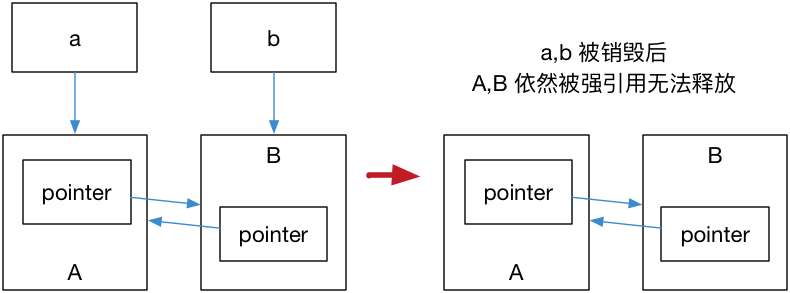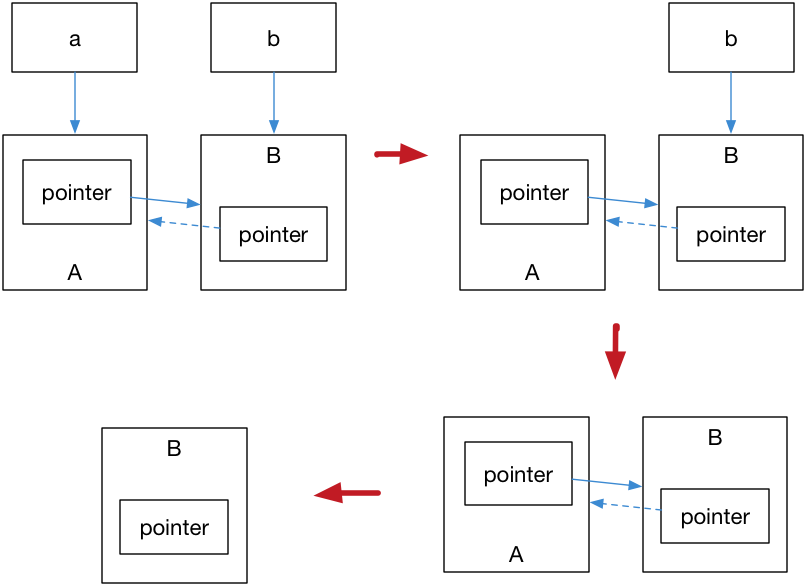星标/置顶 公众号 👇 , 硬核文章第一时间送达 !
链接 | https://changkun.de/modern-cpp/zh-cn/05-pointers/index.html RAII 与引用计数 了解 Objective-C/Swift 的程序员应该知道引用计数的概念。引用计数这种计数是为了防止内存泄露而产生的。
基本想法是对于动态分配的对象,进行引用计数,每当增加一次对同一个对象的引用,那么引用对象的引用计数就会增加一次, 每删除一次引用,引用计数就会减一,当一个对象的引用计数减为零时,就自动删除指向的堆内存。
在传统C++中, 『记得』手动释放资源,总不是最佳实践。 因为我们很有可能就忘记了去释放资源而导致泄露。 所以通常的做法是对于一个对象而言,我们在构造函数的时候申请空间,而在析构函数(在离开作用域时调用)的时候释放空间, 也就是我们常说的 RAII 资源获取即初始化技术。
凡事都有例外,我们总会有需要将对象在自由存储上分配的需求,在传统 C++ 里我们只好使用 new 和 delete 去 『记得』对资源进行释放。 而 C++11 引入了 智能指针的 概念,使用了引用计数的想法,让程序员不再需要关心手动释放内存 。
这些智能指针就包括 std::shared_ptr std::unique_ptr std::weak_ptr , 使用它们需要包含头文件 <memory> 。
注意:引用计数不是垃圾回收,引用计数能够尽快收回不再被使用的对象,同时在回收的过程中也不会造成长时间的等待, 更能够清晰明确的表明资源的生命周期。
std::shared_ptr
std::shared_ptr 是一种智能指针,它能够记录多少个 shared_ptr 共同指向一个对象,从而消除显式的调用 delete,当引用计数变为零的时候就会将对象自动删除。
但还不够,因为使用 std::shared_ptr 仍然需要使用 new 来调用,这使得代码出现了某种程度上的不对称。
std::make_shared 就能够用来消除显式的使用 new,所以 std::make_shared 会分配创建传入参数中的对象, 并返回这个对象类型的 std::shared_ptr 指针。例如:
#include <iostream> #include <memory> void foo (std ::shared_ptr <int > i){ (*i)++; } int main (){ // auto pointer = new int(10); // illegal, no direct assignment // Constructed a std::shared_ptr auto pointer = std ::make_shared<int >(10 ); foo(pointer); std ::cout << *pointer << std ::endl ; // 11 // The shared_ptr will be destructed before leaving the scope return 0 ; }
std::shared_ptr 可以通过 get() 方法来获取原始指针 ,通过 reset() 来减少一个引用计数, 并通过 use_count() 来查看一个对象的引用计数。例如:
auto pointer = std ::make_shared<int >(10 );auto pointer2 = pointer; // 引用计数+1 auto pointer3 = pointer; // 引用计数+1 int *p = pointer.get(); // 这样不会增加引用计数 std ::cout << "pointer.use_count() = " << pointer.use_count() << std ::endl ; // 3 std ::cout << "pointer2.use_count() = " << pointer2.use_count() << std ::endl ; // 3 std ::cout << "pointer3.use_count() = " << pointer3.use_count() << std ::endl ; // 3 pointer2.reset(); std ::cout << "reset pointer2:" << std ::endl ;std ::cout << "pointer.use_count() = " << pointer.use_count() << std ::endl ; // 2 std ::cout << "pointer2.use_count() = " << pointer2.use_count() << std ::endl ; // 0, pointer2 已 reset std ::cout << "pointer3.use_count() = " << pointer3.use_count() << std ::endl ; // 2 pointer3.reset(); std ::cout << "reset pointer3:" << std ::endl ;std ::cout << "pointer.use_count() = " << pointer.use_count() << std ::endl ; // 1 std ::cout << "pointer2.use_count() = " << pointer2.use_count() << std ::endl ; // 0 std ::cout << "pointer3.use_count() = " << pointer3.use_count() << std ::endl ; // 0, pointer3 已 reset
std::unique_ptr
std::unique_ptr 是一种独占的智能指针,它禁止其他智能指针与其共享同一个对象,从而保证代码的安全:
std ::unique_ptr <int > pointer = std ::make_unique<int >(10 ); // make_unique 从 C++14 引入 std ::unique_ptr <int > pointer2 = pointer; // 非法
make_unique 并不复杂,C++11 没有提供 std::make_unique,可以自行实现:
template <typename T, typename ...Args>std ::unique_ptr <T> make_unique ( Args&& ...args ) { return std ::unique_ptr <T>( new T( std ::forward<Args>(args)... ) ); }
至于为什么没有提供,C++ 标准委员会主席 Herb Sutter 在他的博客中提到原因是因为『被他们忘记了』。
既然是独占,换句话说就是不可复制。但是,我们可以利用 std::move 将其转移给其他的 unique_ptr,例如:
#include <iostream> #include <memory> struct Foo { Foo() { std ::cout << "Foo::Foo" << std ::endl ; } ~Foo() { std ::cout << "Foo::~Foo" << std ::endl ; } void foo () { std ::cout << "Foo::foo" << std ::endl ; } }; void f (const Foo &) { std ::cout << "f(const Foo&)" << std ::endl ; } int main () { std ::unique_ptr <Foo> p1 (std ::make_unique<Foo>()); // p1 不空, 输出 if (p1) p1->foo(); { std ::unique_ptr <Foo> p2 (std ::move(p1)); // p2 不空, 输出 f(*p2); // p2 不空, 输出 if (p2) p2->foo(); // p1 为空, 无输出 if (p1) p1->foo(); p1 = std ::move(p2); // p2 为空, 无输出 if (p2) p2->foo(); std ::cout << "p2 被销毁" << std ::endl ; } // p1 不空, 输出 if (p1) p1->foo(); // Foo 的实例会在离开作用域时被销毁 }
std::weak_ptr
如果你仔细思考 std::shared_ptr 就会发现依然存在着资源无法释放的问题。看下面这个例子:
struct A ;struct B ;struct A { std ::shared_ptr <B> pointer; ~A() { std ::cout << "A 被销毁" << std ::endl ; } }; struct B { std ::shared_ptr <A> pointer; ~B() { std ::cout << "B 被销毁" << std ::endl ; } }; int main () { auto a = std ::make_shared<A>(); auto b = std ::make_shared<B>(); a->pointer = b; b->pointer = a; }
运行结果是 A, B 都不会被销毁,这是因为 a,b 内部的 pointer 同时又引用了 a,b,这使得 a,b 的引用计数均变为了 2,而离开作用域时,a,b 智能指针被析构,却只能造成这块区域的引用计数减一。
这样就导致了 a,b 对象指向的内存区域引用计数不为零,而外部已经没有办法找到这块区域了,也就造成了内存泄露 ,如图 1:
图 1
解决这个问题的办法就是使用弱引用指针 std::weak_ptr ,std::weak_ptr是一种弱引用(相比较而言 std::shared_ptr 就是一种强引用)。
弱引用不会引起引用计数增加,当换用弱引用时候,最终的释放流程如图 2 所示:
图 2
在上图中,最后一步只剩下 B,而 B 并没有任何智能指针引用它,因此这块内存资源也会被释放。
std::weak_ptr 没有 * 运算符和 -> 运算符,所以不能够对资源进行操作,它的唯一作用就是用于检查 std::shared_ptr 是否存在,其 expired() 方法能在资源未被释放时,会返回 false,否则返回 true。
总结
智能指针这种技术并不新奇,在很多语言中都是一种常见的技术,现代 C++ 将这项技术引进,在一定程度上消除 了 new/delete 的 滥用,是一种更加成熟的编程范式。
关注 公众 号 「高效程序员」 👇 , 一起优秀!
回复“入群”进技术交流群,回复“1024”获取海量学习资源。 






